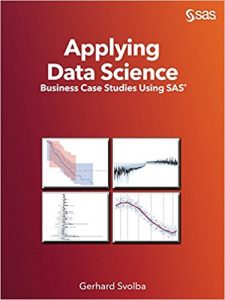 My colleague Gerhard Svolba (Solutions Architect at SAS Austria) has authored his third book, Applying Data Science: Business Case Studies Using SAS®." While the book covers a broad range of data science topics, forecasters will be particularly interested in two lengthy case studies on "Explaining Forecast Errors and Deviations" and "Forecasting the Demand for New Products."
My colleague Gerhard Svolba (Solutions Architect at SAS Austria) has authored his third book, Applying Data Science: Business Case Studies Using SAS®." While the book covers a broad range of data science topics, forecasters will be particularly interested in two lengthy case studies on "Explaining Forecast Errors and Deviations" and "Forecasting the Demand for New Products."
Explaining Forecast Errors and Deviations
This case study deals with the evaluation of forecast quality. Gerhard provides guidance on preparing results (i.e., forecasts and actuals) for analysis. He then illustrates several descriptive statistics and visualizations that go well beyond typical forecast performance reporting.
Linear regression is then used to investigate the influence of input factors on forecast error. While some of the statistical methods may be beyond the comfort zone of a typical demand planner, the book provides plenty of SAS code examples to apply the approach and generate easy to interpret results.
The final section analyzes the effect of manual overrides in forecasting. This material will be especially helpful to anyone doing Forecast Value Added (FVA) analysis of their forecasting process. It shows methods for digging more deeply into FVA results, so you can answer questions like:
- Do manual overrides have a better effect on products with only a short sales history?
- Are larger overrides more beneficial than smaller overrides?
Forecasting the Demand for New Products
This case study shows how forecasts can be generated for products that have no or only a short history of known demand. The study begins with discussion of the preparation and organization of data used for new product forecasting. Gerhard shows how to use Poisson Regression to model the relationship between different product features and the demand in a particular period.
The study also illustrates an alternative approach using similarity search. From all existing products that have sufficient demand history (e.g., one full year of sales), a set of reference products is defined based on similarity to the new product's features. Forecasts for the new product are based on the known demand values of the reference products. (This approach is commonly referred to as "forecasting by analogy." The book provides a rigorous illustration of how to implement it using SAS.)
 Available Now at SAS Books
Available Now at SAS Books
You can purchase Applying Data Science online at SAS Books.
